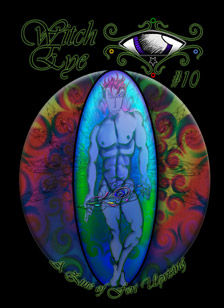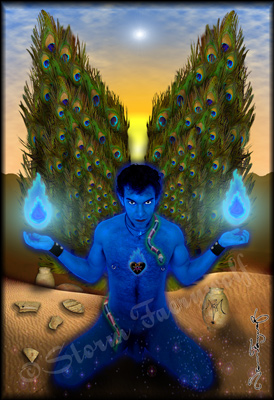"Dian Y Glas"
by Diana Walker
 |
"Introduction To The Blue God of Faery"
The Peacock God is born from the reunion of the Divine Twins back into one Deity. He is seen as holding all duality within Himself, so He is both deeply erotic and seductive, but also destructive and frightening. Many Feri practitioners call Him by the name Melek Taus, the central deity of the Yazidi. In some lines of Feri, the two deities are, in fact, understood as the same being.
The Blue God of Faery has many names, such as the following:
Lord of the Painted Fan
Living Rainbow
Winged Serpent
True Bird of Paradise
Flower King
Nine Spotted Serpent in the Well
Singer in the Wood
Dian Y Glas, variously spelled Dia-na-Glas; Dian-na-Glas; Dia-ny-Glas
Light of the World
Self Fire
Soul of Humanity
God Self
Peacock Angel
He shares certain characteristics and iconography with deities from various pantheons, and so is sometimes also called:
Malik Taus; Melek Ta'us (Yezidi)
Vishnu (Hindu)
Krishna (Hindu)
Hyakinthos (Greek)
Okin Oba Aye (Yoruba)
Lemba; Lembe; Green Boy; Gentle One (Voodoo)
Shaitan (Muslim)
Archangel Michael (Christian)
Lucifer (Roman)

|
From "The Gods of Infinity"
by Storm Faerywolf
Traditionally the Blue God is said to appear as an androgynous youth with an erect phallus and the breasts of a young girl, though he does not appear to me in that guise. To me his "androgyny" is expressed solely in his softness, and indeed at times he appears to me naked and swathed in lavender silks, smiling and dancing seductively amongst the stars. In some teachings He is said to represent our own personal Divinity; our "Higher Selves" to which we pray in order to hasten our own evolution. We are reminded by His iconography that the power that manifests as spirituality is sexual in nature: a serpent coils around His neck, and in fact one of His titles is "the serpent in the well", who is seen rising in the springtime, an obvious phallic reference and may also represent what some practitioners of Tantric mysticism know as kundalini energy. Peacock feathers adorn His hair connecting Him to Melek Ta'us, the Peacock Angel of the Yezidis who, despite outsiders misrepresenting Him as "the devil", regard Him as the true God of this world.

"Lord of The Painted Fan"
by Chas Bogan for Witch Eye Volume 10
 |
From "Feri FAQ"
by Valerie Walker
The Blue God/Melek Taus/Dian y Glas
The firstborn of the goddess is the Blue God, also known as the Peacock Angel, Lord of the Painted Fan, and by some as Melek Taus. The Blue God is regarded by some lines of Feri as the particular patron deity of Feri. The Dian y Glas is usually pictured as a young, blue-skinned, ithyphallic, yet somewhat androgynous god with a serpent. As Melek Taus, the Blue God is the twin of Lemba, the Lord of the Green Flame, also known as the Living Serpent. He is the main deity of the Yezidi people...

"Melek Ta'us; The Peacock Angel"
by Storm Faerywolf

|
From "Feri Crossroads" (expired website)
by anonymous author
You are in a forest at dawn. It is spring. The trees are a tender green, rustling gently with new leaves. Birds are beginning to sing and fly about the tree tops. You smell the fresh scent of the young plants.
Before you is a gently trickling spring, surrounded by delicate flowers. Hyacinths, narcissus, and lilies nod their heads over the pool. Breathe deeply of their sweet hypnotic fragrance.
Gaze into the rippling waters and chant repeatedly, until the presence of the Dia-na-glas manifests: Blue God
Winged Serpent,
Living Rainbow,
Lord of the Painted Fan
From "The Blue God: excerpts from Blue Rose class material"
By Storm Faerywolf
The Blue God is known by many names: the Peacock Lord, Dian y Glas, Melek Ta’us, Lemba, Eros, the Christos, and Lucifer, to name but a few. He is one of our central Gods, but in some myths he is an angel, while in others his origins as a djinn or faery are subtly revealed. He is a shapeshifter; a trickster, and a great teacher. He is paradox: the highest spirit, but also the most primal and low. He is sexual, as well as spiritual, and is the embodiment of both beauty and darkness.
The Blue God is that spark of divinity that resides within us all; the hidden spirit within matter. According to lore attributed to Victor, the Blue God sometimes appears as a winged serpent underneath the left hand of the Goddess. Here, it is said, he is the most beautiful and beneficial of all spirits. But outside of her influence he becomes the most terrible and wrathful. To me this represents the divine masculine balanced by the divine feminine, and the terrible price that is paid when the god force is no longer balanced by the goddess.
...
As Dian y Glas he appears to us as a beautifully alluring blue-skinned youth. Traditional lore depicts him with an erect phallus, the soft breasts of a young girl, a serpent around his neck, and peacock feathers in his hair. He is sometimes shown playing a silver flute. He is the initiating principal of life-force, and the spiritual nature of love, beauty, and sexual passion.
He is associated with springtime as well as with the nourishing waters of rains and of springs. He is the starry-eyed wonder of the world; how a child sees the beauty of the world through eyes that have not been corrupted.
...
When he comes to us as Melek Ta’us our attentions are drawn to the Middle East; most specifically to those people of Kurdish descent in the general area of Northern Iraq known as the Yezidi. To them, Melek Ta’us, known as the Peacock Angel, is the first emanation of the light of God whose special color is blue; blue being considered the most powerful color and the origin for all the others, as all light comes from the sky. Beyond this “signature” color he is said to embody all the colors of the rainbow which is his special symbol. He is the first (and ruler) of the Seven Archangels, containing the other six within himself (just as white light contains all the colors of the spectrum). To the Yezidi he is the Soul of the World; the collective divine presence of humanity. They also believe that he belongs to the whole world, not just to the Yezidi themselves.
According to Islamic myth, the Iblis (Melek Ta’us) was created by God out of “smokeless fire”; a detail that would suggest that his origin is actually as a djinn; as he is quite clearly described as having been created from this particular substance. Angels, by contrast are depicted as being created from light, while mankind from earth, dust, or clay. This detail is seemingly contradictory since Melek Ta’us is quite clearly referred to as an angel in the traditional myths. But our Blue God is not always what he seems. Just as we have seen how he exists in a space of liminality in terms of the male/female and terrestrial/celestial discussed previously, he also would appear to occupy a space between that of faery (or djinn), angel, and god.
...
Whether he comes as the youthful Dian y Glas, or as the virile Melek Ta’us his iconography represents a union of complimentary forces that individually we can understand as the Divine Twins; the “two bright spirits” that the Goddess took into Her womb and perfected into God.
|



